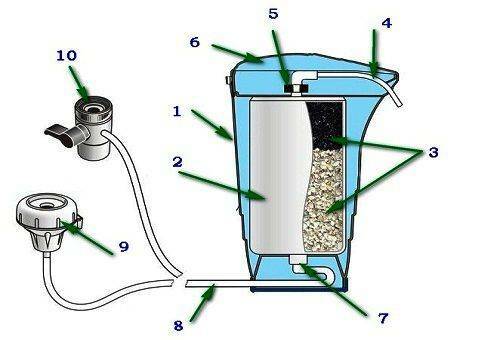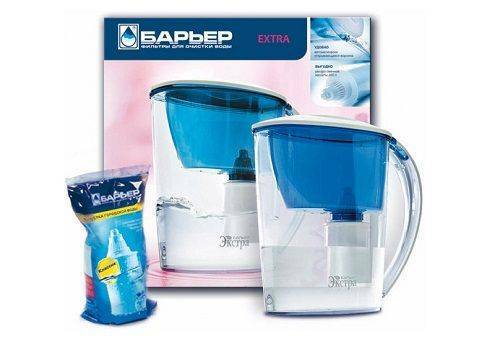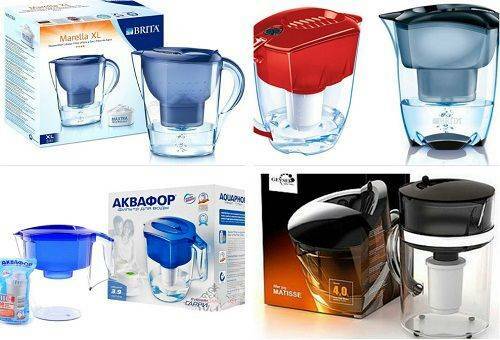- Contents:
- Principle of operation and installation of jug filters
- Advantages and disadvantages of functional devices
- Basic rules for the selection and operation of products at home
The quality of tap water in most modern cities is such that it is better not to drink or use it for cooking without preliminary cleaning. This problem can be solved by choosing a suitable stationary or detached filter. If the first group is represented by expensive and cumbersome devices, the second one offers convenient and cost-effective products.

Special attention should be paid to pitcher-type filters, which can be used at home and in the office without spending a lot of personal time on the process of water treatment. The range of offers is quite impressive, so you need to understand the main characteristics of the products in order to make the right choice.
Principle of operation and installation of jug filters
Jug filters consist of three main parts: a tank for tap water, a filter element for the cleaning process, and the part to which the purified liquid is collected. The most important role is assigned to a filter cartridge, represented by a plastic cylinder with several kinds of fillers. Poor quality of tap water is due not only to its physical properties, but also to its chemical composition.

The scheme of the jug filter
For this reason, the qualitative filter should include the following substances:
- Activated charcoal. Responsible for reducing the level of chlorine in the liquid and neutralizing pathogenic microorganisms.
- Resin with the ion exchange property. Provides water softening, eliminates the excessive content of magnesium and calcium salts, fights with heavy metals.
- Activated charcoal of porous structure. During the cleaning process removes unnecessary mechanical components, eliminates the unpleasant aftertaste and smell of liquid.
- Polypropylene fiber. Retains oversized and insoluble particles.
Thanks to this structure of the device and the multilayered filter, the tap water is carefully cleaned, ensuring that the quality of the liquid is brought to a level at which its use becomes absolutely safe for the organism.
Advantages and disadvantages of functional devices
Before choosing a filter of the pitcher type for your house, you need to compare the advantages and disadvantages of the device.

The scheme of the device of the desktop filter-nozzle
To the positive moments of the use of devices it is possible to attribute the following factors:
- Mobility and ergonomics. Products take up very little space. If desired, they can be placed even on a shelf in the refrigerator. The device does not cause any problems in the process of operation, even the child will cope with the process of recruiting and using water.
Tip: Special attention should be given to models with valves that allow you to gain liquid without removing the lid, a rubberized bottom and spouts. With frequent and long-term operation, such trifles are a pleasant bonus, which facilitates the use of the filter.
- Low cost. The purchase of this product can afford a family with any level of income. True, before buying, it is recommended to clarify the cost of replacement cartridges to the device, it is this expense item that ultimately turns out to be the main one.
- Filter Quality .Despite the fact that pitchers are not leaders in terms of the level of tap water purification, in some cases significantly inferior to stationary structures, numerous studies have proven their high efficiency.
- Attractive appearance. A factor that is much more important than it seems at first glance. Positively influencing the mood, the original products contribute to the regulation of metabolic processes.

Filter-pitcher Barrier
It is impossible not to mention some of the shortcomings of products. First of all, they include frequent replacement of consumables and the possibility of cleaning only at a basic level. Not always consumers are happy with the performance of objects. Their small size sometimes leads to a sharp shortage of drinking water.
Basic rules for the selection and operation of products at home
To choose the right variant of the jug filter, you need to familiarize yourself with the features of the proposals from the leaders of this field:
- Aquaphor .Offers a wide range of adaptations, which differ in the capacity of the jug and the resources of the cartridge( from 170 to 300 liters).The manufacturer offers even reverse osmosis filters that guarantee the maximum possible degree of purification with this approach. Particular attention is paid to the quality of sorbents, they are even able to enrich the fluid with useful components.
- Barrier. A distinctive feature of the manufacturer is the availability of mineralizers in the kit. Those. In addition to standard water treatment, one can expect to improve its mineral composition.
- Geyser. From previous models differs only in lower cost and lack of additional options. But their cartridges can be changed no more than every 350-400 liters.

Regardless of which product was purchased, the following points should be kept in mind during the operation of the product:
- The quality of the cleaning depends on the composition of the water. Suspecting too much contamination of the liquid, before choosing a standard pitcher, it is better to conduct an expert evaluation of the composition. Perhaps such an impact is not enough.
- The average cartridges are recommended to be changed every 2-3 months, but this point needs to be clarified even before the start of operation. It is absolutely forbidden to use non-native components for the filter!
- If the degree of water hardness is excessively high, it is better to initially take a pitcher whose cartridge life is calculated for 400 liters.
- After the first treatment of water, the liquid must be poured out. Only after the second approach it can be used.
- For cleaning in jug filters, only cold tap water is suitable. Experiments with warm, boiled or drinking water is better not to conduct.
- In the pitcher, the purified water can not last longer than 2-3 days. If it was not used, it is better to pour it.
To maintain the cleanliness of the appliance, it is necessary to wash it regularly with warm water and a mild soap solution, otherwise there is a risk of calcareous deposits on individual elements.
Read the article on how to clean water from iron
